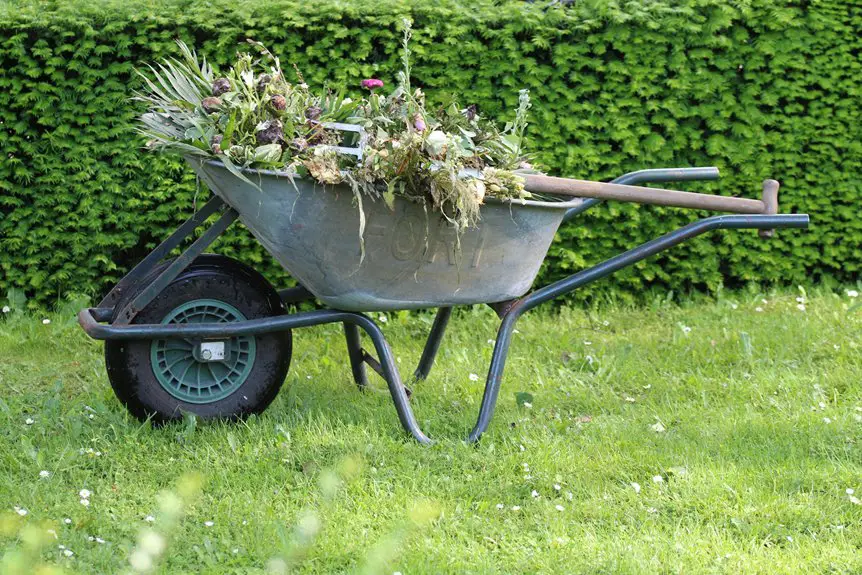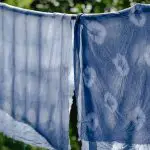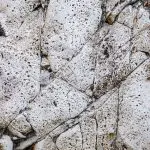Yes, you need to pull weeds before putting down lawn fabric. Removing them stops weeds from competing with your grass and prevents roots from damaging the fabric. Clearing all weeds and roots gives you a smooth soil base, making the fabric work better to block new weed growth. If you don’t, weeds can grow through or around the fabric, shortening its lifespan. Keep following along to discover how to prep and install fabric for the best results.
Table of Contents
Key Takeaways
- Always remove all existing weeds and their roots before installing lawn fabric to prevent regrowth and fabric damage.
- Pulling weeds creates a clean soil surface, allowing the fabric to effectively block new weed growth.
- Removing weeds ensures the lawn fabric lies flat without bumps or gaps, improving coverage and durability.
- Prepare soil by raking and leveling after weed removal to promote healthy grass and proper fabric installation.
- Skipping weed removal causes persistent weeds to grow through or around the fabric, reducing its effectiveness.
Why Removing Weeds First Is Crucial
Before laying down lawn fabric, you need to remove weeds thoroughly because they compete with your grass for nutrients and water.
If you don’t pull them out first, those weeds can quickly take over, making your efforts to grow a healthy lawn futile.
Plus, weeds often have deep roots that can push through or damage the fabric, reducing its effectiveness.
Weeds with deep roots can penetrate and damage lawn fabric, compromising its ability to protect your lawn.
By removing all weeds upfront, you create a clean slate that allows the fabric to act as a proper barrier.
You’ll save time and frustration since you won’t have to deal with persistent weed regrowth later.
Taking this step seriously guarantees your lawn fabric can do its job well, helping your grass thrive without unwanted competition from invasive plants.
How Weeds Affect Lawn Fabric Performance
You’ll notice that weed growth can quickly compromise your lawn fabric’s effectiveness, causing tears and gaps.
These disruptions shorten the fabric’s lifespan and reduce its ability to block unwanted plants.
Understanding how weeds impact fabric durability helps you protect your lawn investment better.
Weed Growth Impact
Although lawn fabric is designed to suppress weed growth, persistent weeds can still penetrate or grow around it, reducing its effectiveness.
When weeds manage to push through small gaps or edges, they create openings that compromise the fabric’s barrier. This allows more weeds to take root, making your lawn fabric less reliable over time.
Additionally, aggressive weed roots can lift or tear the fabric, leading to bare spots where even more weeds thrive.
If you don’t address these issues promptly, weeds will spread underneath the fabric, causing uneven surfaces and damaging your lawn’s appearance.
Fabric Longevity Factors
Since weeds can penetrate and damage lawn fabric, their presence directly shortens the fabric’s lifespan.
When weeds grow through or under the fabric, they create gaps and tears, weakening its structure. This allows water and soil to erode the fabric faster, reducing its effectiveness as a weed barrier.
If you don’t remove weeds before installing the fabric, you’ll likely face more frequent replacements and repairs.
Also, persistent weed roots can push the fabric upward, causing uneven surfaces that affect your lawn’s appearance and drainage.
To maximize fabric longevity, pull weeds thoroughly before laying it down, and maintain regular weed control afterward.
This proactive approach helps your lawn fabric perform well longer, saving you time and money on maintenance and replacement.
Best Techniques for Effective Weed Removal
To tackle weeds effectively, you first need to recognize the common types invading your lawn.
You’ll want to weigh the pros and cons of manual versus chemical removal methods.
Plus, choosing the right time to extract weeds can make all the difference in keeping your lawn fabric intact.
Identifying Common Weed Types
Before you tackle weed removal, you need to recognize the common types invading your lawn. Knowing what you’re up against helps you choose the best removal method. Common weeds include dandelions, crabgrass, clover, chickweed, and plantain. Each has unique characteristics and growth habits.
Here’s a quick reference:
| Weed Type | Identification Feature | Growth Pattern |
|---|---|---|
| Dandelion | Yellow flower, jagged leaves | Deep taproot |
| Crabgrass | Broad, coarse blades | Spreads quickly |
| Clover | Three leaflets, low-growing | Spreads via runners |
| Chickweed | Small white flowers | Creeping stems |
| Plantain | Broad, oval leaves | Rosette form |
Spotting these early makes removal easier and prevents lawn damage.
Manual vs. Chemical Removal
Recognizing the types of weeds in your lawn sets the stage for choosing how to remove them effectively.
You can opt for manual removal if you’re dealing with a small area or individual weeds. Pulling by hand or using a weeding tool lets you target roots directly, preventing regrowth without chemicals. It’s eco-friendly and ideal for sensitive areas.
However, if you’re facing widespread or persistent weeds, chemical removal might be more efficient. Herbicides can quickly control tough weeds but require careful application to avoid harming your grass or surrounding plants. Always follow label instructions and consider spot treatments to minimize chemical use.
Balancing manual and chemical methods based on your lawn’s needs will help you achieve a cleaner, healthier yard before laying down lawn fabric.
Timing for Weed Extraction
Choosing the right time to extract weeds can make a huge difference in how effectively you control them. You want to pull weeds when the soil is moist, ideally after a rainfall or watering. This softens the ground, making it easier to remove roots completely and preventing regrowth.
Avoid weeding during hot, dry spells since dry soil causes roots to break, leaving parts behind to regrow. Early morning or late afternoon offers cooler temperatures, making the task more comfortable and reducing plant stress.
Also, try to weed before the plants flower and set seeds to prevent spreading. By timing your weed removal correctly, you’ll reduce the chance of weeds returning and create a cleaner base before laying down lawn fabric.
Preparing the Soil Before Installing Lawn Fabric
Although installing lawn fabric might seem straightforward, preparing the soil properly is essential to confirm its effectiveness against weeds. You need to create a smooth, clean base to make sure the fabric lies flat and prevents weed growth efficiently.
Proper soil preparation ensures lawn fabric lays flat and effectively blocks weed growth.
Follow these steps to prepare your soil:
- Remove all existing weeds and roots to stop regrowth beneath the fabric.
- Rake the soil to level it, eliminating bumps and debris.
- Loosen compacted soil with a garden fork or tiller to improve drainage.
- Add a thin layer of topsoil or compost if needed to promote healthy grass growth above the fabric.
Taking these steps guarantees your lawn fabric works as intended, providing a long-lasting barrier against weeds.
Tips for Laying Lawn Fabric Correctly
Once you’ve prepared the soil, you’ll want to lay the lawn fabric carefully to guarantee it stays in place and effectively blocks weeds. Start by rolling out the fabric smoothly, avoiding wrinkles and overlaps. Secure the edges with landscape staples every 12 inches, and overlap sheets by at least 6 inches to prevent gaps. Cut holes only where plants will grow, minimizing exposed soil.
| Step | Tip | Why It Matters |
|---|---|---|
| Roll Out | Keep fabric taut | Prevents wrinkles and gaps |
| Overlap Sheets | 6-inch minimum overlap | Blocks weed growth between sheets |
| Secure Edges | Use staples every 12 inches | Keeps fabric from shifting |
| Cut Holes | Cut only for plants | Minimizes weed entry points |
Maintaining a Weed-Free Lawn After Installation
Laying lawn fabric properly sets a solid foundation, but keeping weeds at bay requires ongoing attention. After installation, you can’t just set it and forget it.
To maintain a weed-free lawn, follow these key steps:
- Regularly inspect the fabric edges for any gaps where weeds can sneak in and secure them tightly.
- Remove any weeds that manage to grow on top or around the fabric immediately before they spread seeds.
- Apply a layer of mulch or gravel over the fabric to block sunlight, reducing weed germination.
- Guarantee proper lawn irrigation without overwatering, as excess moisture encourages weed growth beneath the fabric.
Frequently Asked Questions
What Types of Lawn Fabric Are Best for Different Climates?
You’ll want durable, UV-resistant fabric for sunny, hot climates, while breathable, moisture-permeable types suit humid areas. In colder zones, thicker, frost-resistant fabric works best. Match fabric properties to your local weather for ideal lawn care.
Can Lawn Fabric Be Used Under Mulch or Gravel?
Think of lawn fabric as a shield protecting your garden’s soul. You can definitely use it under mulch or gravel to block weeds, letting your plants thrive while keeping the soil healthy and moisture locked in.
How Long Does Lawn Fabric Typically Last Before Replacement?
Lawn fabric typically lasts 5 to 10 years before needing replacement. You’ll want to check for tears or degradation regularly, especially in high-traffic areas, to keep your garden weed-free and healthy.
Is It Safe to Install Lawn Fabric Around Flower Beds?
You can safely install lawn fabric around flower beds, but be careful not to smother your plants. Cut the fabric to fit closely, allowing space for growth, and secure edges to prevent weeds while keeping flowers healthy.
Can Lawn Fabric Prevent Soil Erosion on Slopes?
Back in the days of knights and castles, you’d find that lawn fabric can help prevent soil erosion on slopes by holding soil in place and reducing runoff. You’ll want to secure it properly for best results.
- Are Merrell Gore-Tex Shoes Reliably Waterproof? - July 2, 2025
- Is Gore-Tex Being Discontinued? Fact vs. Fiction - July 2, 2025
- What Is the Lifespan of Gore-Tex Shoes? - July 2, 2025







